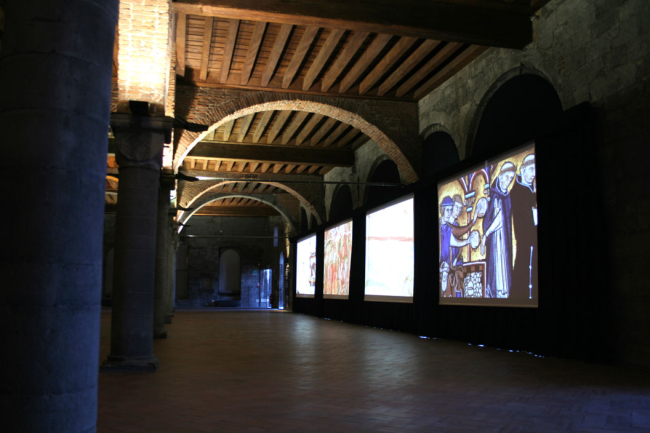Commenda di San Giovanni di Pré
A sacred, uniquely intact Romanesque edifice, the “Commenda” is instantly recognisable from afar and, once seen, lingers long in the memory, with its stark black Promontorio stone, series of arches, imposing bell tower, two overlapping churches and a Museum Theatre which evokes the most profound history of pilgrims and crusades.
History
The term “commenda” refers to the friary and hospital-hostel commissioned in 1180 by the Cavalieri Gerosolomitani or Knights of St. John of Jerusalem, the religious and military order tasked with providing pilgrims with support and shelter and offering hospitality for wayfarers, knights and merchants travelling to the Holy Land, where the Third Crusade was being fought at the time. At the base of the bell tower, an epigraph commemorates Friar Guglielmo, the founder of the Commenda.
“Prè” means “meadows” in the local dialect, as this area close to the city walls was previously occupied by an agricultural settlement with its farmland. The location was chosen for its proximity to the port and to the main road route for travellers arriving from Northern Italy, as well as its convenient access to drinkable water from the Sant’Ugo River nearby. It was also a sacred site, where the ancient Church of the Holy Sepulchre stood (records suggest as early as 636). At the time of the First Crusade, the ashes of Saint John the Baptist had been interred here; they were subsequently transferred to the present-day cathedral.
Over time, in addition to its function as a hostel, the site came to be a hospital for the city’s sick and poor.
The two churches
The upper church, today dedicated to Saint John the Evangelist, stands out against the maze of narrow alleyways with its stark bell tower, classically Genoese Romanesque forms, four pinnacles, elegant pyramidal cusp and three orders of three-mullioned windows.
The basilica was originally built without a façade, being reserved for the knights, who entered it via a passageway inside the hostel. When the church was open for public worship, in the eighteenth century, its orientation was reversed by opening a portal in the apse. This portal still welcomes worshippers today.
Having crossed this unconventional threshold, one enters an interior that is no less remarkable for the extremely unusual light produced by the black stone known as pietra nera di Promontorio, which is set off against the light colour of the plastered surfaces and makes for an elegant contrast, which is taken up by the chequered floor.
The aisles are adorned with paintings and frescoes by Giulio Benso, Bernardo Castello, Carlo Giuseppe Ratti, Lorenzo De Ferrari, Lazzaro Tavarone, Giovanni Domenico Cappellino and Simone Barabino.
The lower church, with its bright, elegantly cross-vaulted nave and aisles, was originally dedicated to Saint Ugo da Genova and used as a gathering place for pilgrims; it was subsequently given over for use by the confraternities.
La Commenda
The building is laid out on three floors, which are mirrored in the façade with two elegant series of arches and an arcade:
- the ground floor: a single, large hall with tall stone columns, where pilgrims slept in simple beds set against the walls on which several shelves are still visible, some of them to place their belongings on, others for washing, with drainage holes.
A concealed passageway led away from the hall, enabling the knights to reach the wharfs and embark without having to leave the building, in the manner of a modern hub.
- the first floor: characterised by a fine wooden ceiling and, as already mentioned above, by its function in providing a connection to the church on the upper floor;
- third floor: with a number of frescoed rooms still preserved today, it was probably reserved for the friars.
The Museum
The Commenda houses the MEI - National Museum of Italian Emigration where it is possible to retrace many stories of Italian migration, from the Unification of Italy (and even before) to the present.
For information about prices and opening times, please see the building’s website.










